It’s often said that anyone who has visited Algonquin Provincial Park in Ontario is in for a disappointment when they get to heaven. And that may be true, it only takes a few hours of gliding across the park’s crystalline lakes and streams, one night camping beneath the outstretched canopy of the tall red pines, or a moment witnessing the awesome beauty of the waterfalls to understand the inspiration.
You can also see it in the work of Tom Thomson, one of the Group of Seven, Canada’s world-famous landscape painters. Among many of his immortal sketches and paintings of the park is “Woodland Waterfall” in 1916-17 of an unknown falls in the park.
Ecologically diverse and rife with history, Algonquin Provincial Park seamlessly provides deep-woods adventures, excellent day trips, and weekend getaways for the residents of Toronto to the west and Ottawa to the east.
If you’re planning to visit the park you should keep in mind it’s a pretty wild place and fending for yourself is pretty well your only option once you’re a few paddle strokes into your journey. For that reason there are certain things you should always carry with you before you set off into the bush, including a sturdy camp or survival knife. If you don’t already have one take a look at the Gerber StrongArm. This rugged, high quality, ceramic and stainless blade will stand up to a lot of abuse, which is exactly what you need in a camp knife. It’s solid enough to easily baton firewood, and manageable enough to clean a fish.You can pick one up on your way into Algonquin Park at Canadian Tire. They have stores surrounding the east side of the park. Visit Canadian Tire for specific locations.
During your trip plan to visit the many breathtaking waterfalls of all shapes and sizes throughout the park. There’s something enthralling about the awesome power of thousands of cubic meters of water crashing down from a great height. Conversely there’s something incredibly tranquil about sitting by a river or stream where the persistence of time has worn through the granite creek bed to send the stream giggling over a small precipice to create whimsical little falls.
Here are a few of the best falls in Algonquin Provincial Park, (some likely to have been the subject of a Thomson sketch or painting).
1. Ragged Falls and Gravel Chute Falls
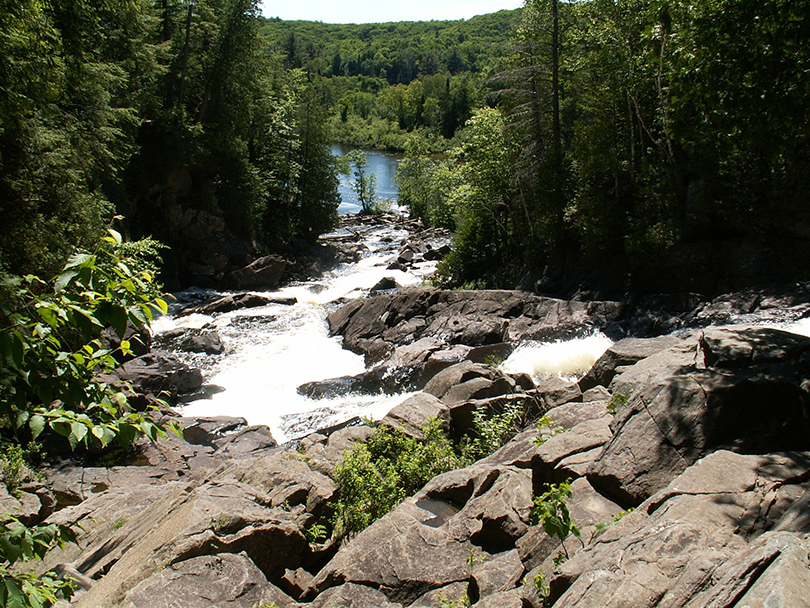
Ragged Falls | Photo Credit
Ragged Falls Provincial Park | selbst gemacht
While not technically within the boundaries of Algonquin Park proper, Ragged Falls is a popular and easily accessible set of falls located northeast of Huntsville in Oxtongue River/Ragged Falls Provincial Park, just outside of Algonquin Provincial Park. These are also one of the few sets of falls located on the west side of Algonquin.
The Oxtongue River follows out of headwaters in Algonquin itself, and unlike many other falls in the region this is a wild waterfall which has not been dammed or diverted in any way.
The 80-foot Ragged Falls are a very popular destination for families on day trips, and since it accessible by a short walk on a well-maintained trail, it can get a bit crowded in the high season.
If you’re feeling a little more adventurous you can paddle upstream from Ragged Falls to the equally splendid, and less frequented, Gravel Chute Falls. If you’re able to book in advance there’s also a beautiful campsite right at the top of these falls!
2. Falls on the Track and Tower Trail
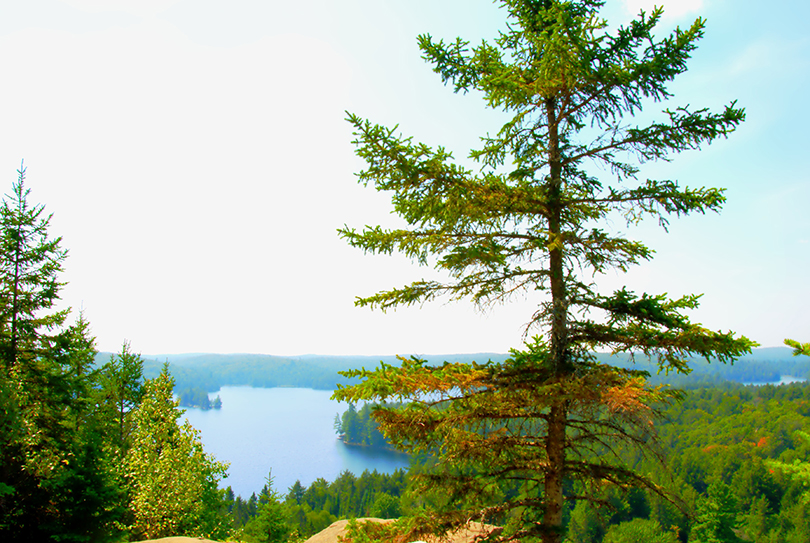
The view of Cache Lake from Track and Tower Trail | Steve Singer
If you could bottle an Algonquin Park experience it would probably have all the ingredients of the Track and Tower Trail. The trail offers the perfect overview of the park’s geology, history, and diversity in a bite-sized 4.7-mile loop.
The highlight of this trail for many people is the lookout over Cache Lake which offers a stunning view of the southwest end of the park, however the trail also offers several lovely serene moments along the Madawaska River including small waterfalls you can dip your feet in.
The trail also serves to highlight the logging history of the park in the form of the optional 3.3-mile side track on the abandoned Booth Railway Line.
While this trail is well maintained it can be challenging with lots of changes in elevation and a fair share of roots and slippery moss-covered rocks.
3. Hornbeam Lake Falls
One of the better kept secrets in Algonquin Park are the interactive falls on Hornbeam Lake.
Hornbeam is accessible by canoe or kayak from the put-in at Park Access 1 on Kawaywaymog Lake on the North-West end of the park. Getting into the park from here is a breeze too since there’s a Permit Office and convenient Outfitter nearby.
From Kawaywaymog Lake you can paddle in to North Tea Lake via Amable du Fond River. From there you if you continue east toward Biggar Lake you’ll come to a 240-metre portage which leads you onto Hornbeam Lake.
Most folks paddle past on their way to a campsite on adjacent Biggar Lake, but if you have time you can treat these 6-foot falls like a natural water slide and cold-water jacuzzi. If you’re feeling a little bit like Louis and Clark, you can ride your canoe or kayak over these falls fairly safely.
4. High Falls at Caracajou Creek
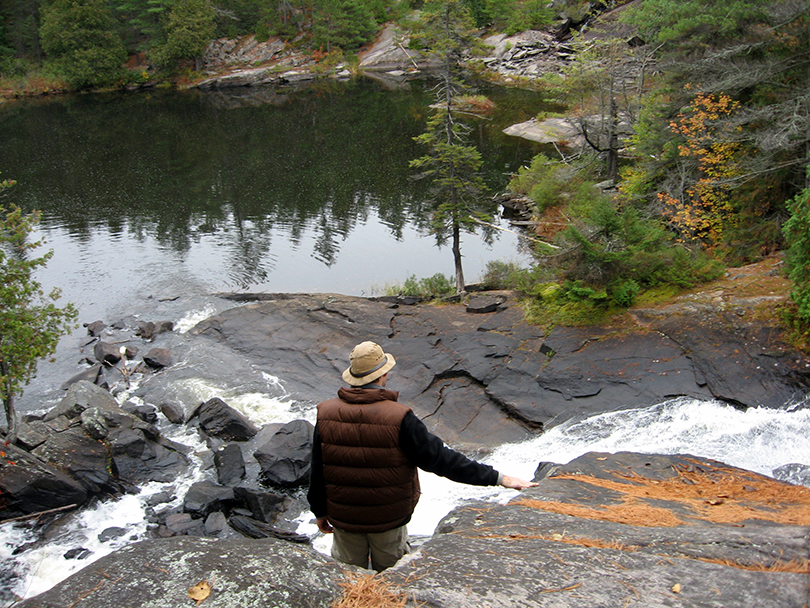
High Falls | Padraic
If you happen to be camped at Achray Campground on the east side of Algonquin Park you can take in the High Falls on Caracajou Creek. Only about an hour-long paddle down Caracajou Bay from the beach at Achray campground and just before the first portage are two small but beautiful falls.
Before or after you paddle, you can enjoy a short hike along the Jack Pine Trail. This short jaunt, which is just under a mile, will take you to one of the park’s most historic landmarks, the spot where Tom Thomson’s famous The Jack Pine painting was inspired. You can learn more about the painting by reading the informational sign that marks the location.
5. High Falls at Barron Canyon and the Water Slide
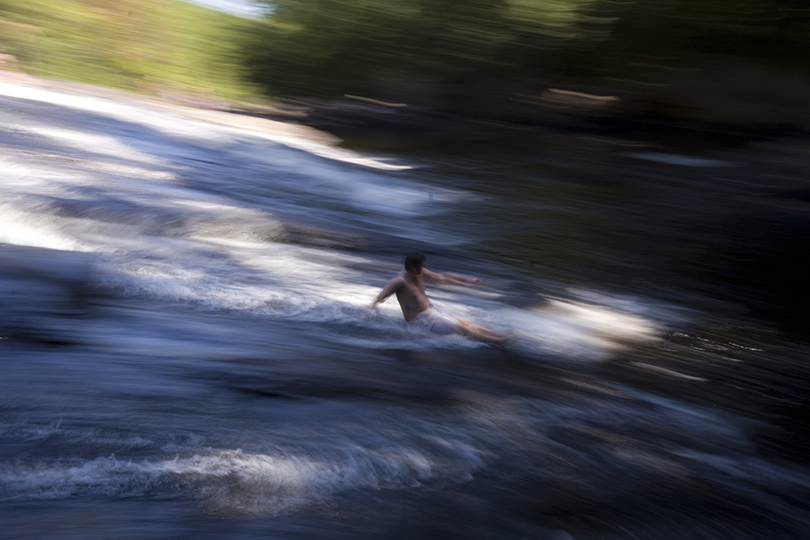
Sliding down at High Falls | Rick Harris
The undisputed main attraction of the Eastern Grand Lake Area of Algonquin Park are High Falls on Barron Canyon. Here Stratton Lake drains into High Falls Lake through a series of small waterfalls crossing two 50-foot contour lines over half a kilometer or so forming a series of cascades. One in particular provides a natural waterslide between two pools.
The result of thousands of years of draining is a picturesque series of small falls about 3-feet high dropping into pools and then culminating in High Falls with a drop of about 30-feet.
This beautiful natural oasis is a memorable destination for a day trip or as a tangent on your canoe camping trip.
There’s a 3-mile trail to High Falls that is maintained and marked just off the Barron Canyon Road. The trail itself is not very challenging and well worth it.
Featured image provided by Padraic






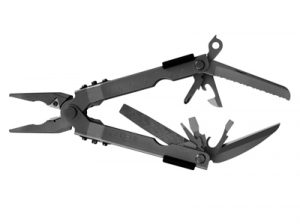

Thanks so much for this info. We will deffinitley be checking some of these out this summer on our Algonquin camping trip! Great info.
We have not visited Algonquin in years but enjoyed many camping trips there with our children and was never ever disappointed. Lovely Provincial Park. We plan on camping there this year.
Tom Thompson was not one of the group of seven. He died before they were formed.
Your right Tom did die before the group was formed. However it is documented that he collaborated with them and was part of the group of 7 in some respects.
People often confuse this fact and assume he was a member of the group of 7.